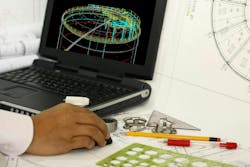Simpler, Smaller and Smarter: Simulation Tactics for Better Product Design
As humans, we are a people of motion. We are built to excel, to brave new heights and to do great things. I’ve spoken with many customers who are new to simulation and have the burning desire to jump into the most physically complex problem that their organization is facing.
That’s great! You want your simulation team to be passionate and take on big challenges. However, there are times where taking a smarter and more deliberate step can have a greater impact on products and the business.
Don’t Skip Building Your Foundation
Have you ever been to the gym and thought to yourself, “I bet I could lift those 50-lb dumbbells” without starting at a more responsible weight? I certainly have! But what I learned was that when you skip building the core foundation, whether it’s your body or in simulation, you can do more harm than good.
READ MORE: Simulation Aids in Product Development and Design Across Industries
And while you won’t pull a muscle trying to simulate very complex problems, you aren’t going to build key skills that will make you a great simulation engineer. The temptation to find that five-minute video tutorial on how to set up a conjugate heat transfer model or an explicit dynamics drop test is hard to ignore. Although it likely will help you understand the what of the problem, it may not teach you the why. Here are some quick pointers to consider:
- Physics. Do I understand the math behind what I’m trying to simulate? Can I confidently translate it conceptually into my problem through the software GUI (graphic user interface)?
- CAD cleanup. What do I do if I don’t have “clean” CAD that requires a lot of surface repair? Do I know when and why I can delete certain features but not others? How will that impact my overall results in the model?
- Meshing. Do I conceptually understand how mesh impacts accuracy of the model in terms of element size, shape and density? Do I know which parts of my model require more refinement than others? Do I even know what these other buttons do in the meshing application, and how they can help or hinder my mesh quality?
- Solver setup. Why should I be choosing this solution method instead of another one? Do I fundamentally understand why I’m selecting certain options and not others? Do I know how to check for model convergence and when the model actually converges? Can I interpret the data and create compelling quantitative and qualitative results?
If you find yourself struggling with the basics, it’s best to take a step back and build up to that big problem you want to solve first. You can review some material on the Ansys Learning Hub (ALH), which has a lot of great content from live training to workshops and everything in between to get you going.
Learning takes time; there are no shortcuts. If you are under a big time constraint, consider working with a consultant that can help you improve your skill set. RandSim, for example, has many enablement offerings, including mentoring hours, 101 training or Fast Start Programs.
Simplifying Your Problem Is Actually Smarter Than You Think
Complexity does not equal accuracy. For every layer of physics complexity that is added to your simulation, you need to understand and control it. If you don’t, the model becomes less accurate. For this reason, it is best to start simple and gradually add complexity to that model as you understand the impact it has.
READ MORE: A Short Guide to Fatigue Failure in Machine Design
The reality is that some of the best simulation engineers in the industry are the ones who know how to strike a balance between model simplicity and complexity. In the 80/20 rule, 80% of the outcomes come from 20% of the causes.
Likewise, in simulation, the most meaningful insights to be gained can stem from simplified models that don’t require tons of complex physics to be captured. For example, if you are in the conceptual stage of design, your simulation models will naturally be faster and less complex.
Remember, in design concepting stages of product development, the objective is to eliminate poor designs so that you can financially and developmentally focus on the best design(s) for production. Likewise, when you are ready to take a design to production and/or certify the product, higher-fidelity modeling with more physical complexity requirements will be critical.
READ MORE: R&D Spotlight: Designing a Test Bench for Armored Vehicle Suspensions
Leveraging the right tool for where you are in the development process will expedite the design insights gained while ensuring the product is robust enough for when it gets into customers’ hands.
An Invitation to Pause, Breathe and Slow Down: Simulation Is a Journey
Simulation, like any discipline, takes time to learn and use effectively. The next time you’re feeling overwhelmed with learning simulation, or any new skill or concept, do something counterintuitive: pause.
The sky is not falling, the roof is not burning down. And while you cannot control the situation, you can control your response to it. Slow down, think straight and walk with deliberate steps on your journey into simulation.
About the Author

Krystian Link
CFD Application Engineer, RandSim
Krystian Link is a CFD application engineer at RandSim, with more 10 years of product development experience in the automotive and manufacturing industries. His simulation experience focuses on vehicle thermal management, external aerodynamics simulations and HVAC systems, including a publication in SAE’s Journal of Commercial Vehicles (“CFD Windshield De-icing Simulations for Commercial Vehicle Applications”). He has an MBA from Indiana University’s Kelley School of Business.

